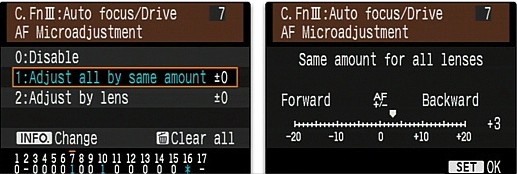An intriguing new feature in the latest pro Canon DSLR
It was a rite of passage when using my rangefinder Leica bodies – the M2 and M3. Should the rangefinder alignment go out for whatever reason, you would go outside, place the camera on a tripod, focus on infinity then remove the lens. Sighting the rangefinder, lateral out-of-alignment would be corrected by using a right angled flat bladed screwdriver on the roller cam, which is eccentrically mounted. Replace the lens, check, repeat if necessary.
Vertical alignment was even easier – with the lens in place, remove the small chrome screw next to the rangefinder window on the front and use a jeweler’s screwdriver on the slotted screw thus disclosed.
This was called ‘adjusting the rangefinder’.
Much the same your friendly Leica repair specialist would do, though for your $250 you would get a three month waiting list and the obligatory German accent should you actually be lucky enough to reach this exemplar of the mechanical arts on the phone. If lucky to get him, you could plead for the return of your body after the obligatory three month absence. Good luck.
Aaah, Leica ownership. Like owning a Jaguar. You need two. One for the garage while the other is in the shop. You also need two mechanics in case one breaks down.
So lo and behold, what does the new professional grade Canon 1D Mark III offer? Why, a modern electronic version of this same feature. I quote from the awesome (as in 720 page!) B&H Digital Photography catalog which the local fork lift operator just delivered:
“AF Micro-adjustment is another example of the flexibility of the Mark III’s AF system. If a critical photographer ever finds that his system seems to consistently focus slightly in front of or behind the intended subject, the AF Micro-adjustment (C.Fn III – 07) allows the user to adjust this in fine increments to put the sharpest plane of focus back where they’d (sic) like it to be. It even allows different adjustments for up to 20 different Canon EF lenses if necessary”

So it sounds like Canon has not only added an overall adjustment to correct for an incorrectly adjusted focus sensor, they have also made it possible to key this adjustment to your lens of choice, recognizing that manufacturing tolerances would, inevitably, result in mis-collimated lenses. So you adjust things in the camera rather than at the manufacturing stage, suggesting a very smart way of keeping the cost of lenses within reason.
Now this latest Canon camera holds no interest for me. It uses a cropped sensor, making my wide angles less wide. Even if it had a full frame sensor I would not be a buyer as I simply do not need battle toughness or 10 frames a second capability, nor the massive bulk of the fixed battery grip.
But it’s nice to know that this feature will be coming to more ordinary bodies down the road, as these things inevitably do.
For some stunning Canon publicity images from this new camera, which claims a sharper sensor than its predecessor (these are clickable BIG downloads), click here. Make sure you check out Sample Image 7 – taken on the 85mm f/1.8 – the cheapest optic used and quite superb, as I know from personal experience.